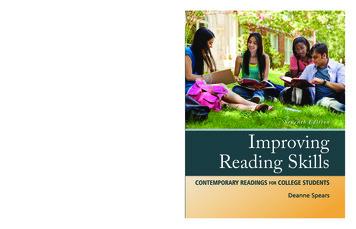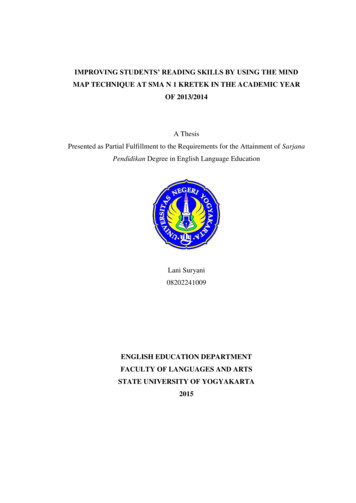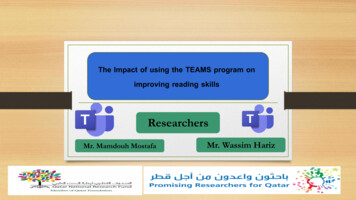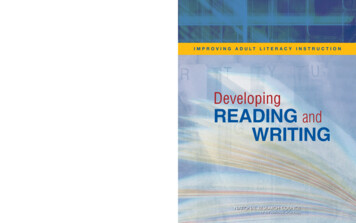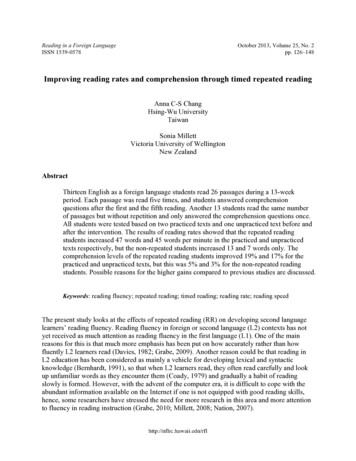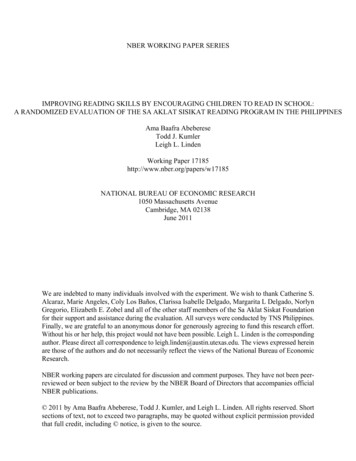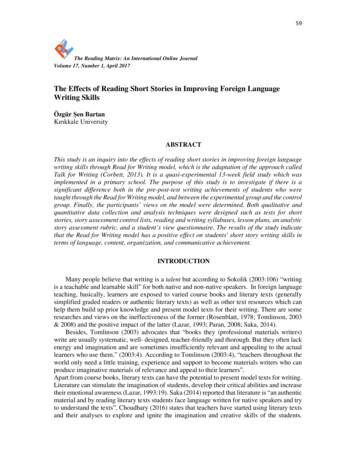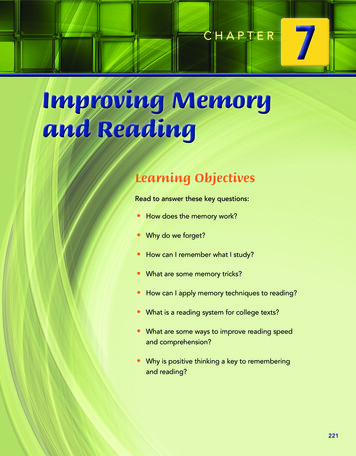
Transcription
CHAPTER7Improving Memoryand ReadingLearning ObjectivesRead to answer these key questions: How does the memory work? Why do we forget? How can I remember what I study? What are some memory tricks? How can I apply memory techniques to reading? What is a reading system for college texts? What are some ways to improve reading speedand comprehension? Why is positive thinking a key to rememberingand reading?221
Learning how to improve your memory and remember what you read will be a greatasset in college, on the job, and in life in general. This chapter describes how memory works and provides some practical techniques for improving your memory. Onceyou understand how memory works, you can apply these techniques to remembering whatyou read. Positive thinking will help you be successful in remembering and readingeffectively.Improving Your MemoryHow Does the Memory Work?Understanding how the memory works provides the framework for effective study techniques. There are three stages of memory: sensory register, short-term memory, andlong-term memory. Understanding these stages of memory will help you learn how tostore information in your long-term memory, which lasts a lifetime. Sensory register. The first stage of memory is called sensory register. It is the initialmoment of perception. This stage of memory lasts less than a second and is used torecord sensory experience (what you see, hear, taste, touch, or do). It is like a quicklyfading snapshot of what your senses perceive. The purpose of the sensory registeris to allow the brain to process information and to focus on relevant information. Toremember information for more than a second, it must be transferred to short-termmemory. Short-term memory (STM). Paying attention to the information you have perceivedin the sensory register transfers the information to STM. STM is temporary andlimited, lasting only about half a minute. The information must be rehearsed orrenewed for longer storage. STM records what we see, hear, feel, taste, or touch.Information is best stored in STM through recitation or mentally talking to ourselves.If the information is not repeated, it is very quickly lost. For example, when you meeta person for the first time, the person’s name is often quickly forgotten because it isonly stored in short-term memory. The purpose of STM is to ponder the significanceof the stimuli we have received, detect patterns, and decide if the information isimportant enough to remember.Grouping together or chunking bits of information can increase the limitedcapacity of STM. George Miller of Harvard University found that the optimum numberof chunks or bits of information that we can hold in STM is five to nine.1 For example,we remember telephone numbers of seven digits by using a hyphen to separate thenumbers into two more easily remembered chunks. We divide our Social Securitynumbers into three chunks for easier recall.According to George Miller’s research, we often use the “Magical Number Seven”technique to remember material. It is much easier to remember material that isgrouped in chunks of seven or less. You can find many examples of groups of sevenused to enhance memory. There are seven days of the week and seven numbers inyour driver’s license and license plate. There are also seven dwarfs, seven deadlysins, and seven wonders of the world! Long-term memory (LTM). Long-term memory has a large capacity and is used tostore information more permanently. You will want to use your LTM to store importantinformation that you want to be able to recall at a later date. Most psychologistsagree that once information is in LTM, it is there forever. Although the information isavailable, the problem becomes how to access it. Think of LTM as a library in whichmany available books are stored. If the books in the library are randomly stored,retrieval of information becomes extremely difficult. If the books are properly storedand indexed, we can find them more easily.222Chapter 7Improving Memory and Reading
How are long-term memories formed? Short-term memories become long-term throughrepetition or meaningful association. Creating long-term memories takes some purposefulaction. We are motivated to take some purposeful action to remember if the informationhas some survival value. When we touch a hot stove, this memory moves from sensoryregister to short-term memory and then is stored in long-term memory to avoid injury inthe future. In an academic setting, we must convince ourselves of the survival value ofwhat we are learning. Is the information needed to pass a test, to be successful in a career,or for personal reasons? If so, it is easier to take the action required to store informationin long-term memory. Emotions such as fear, anger, or joy are also involved in the storingof memories. In the hot stove example, fear elevates the importance of the memory andhelps us to store it in long-term memory. In the educational setting, an interest or joy inlearning helps to store information in long-term memory.It is interesting to note that computers are designed much like STM and LTM. TheRandom Access Memory (RAM) is the working and calculating part of the computer andcan be compared to the STM. When the computer is turned off, the contents of RAM disappear, just as information quickly disappears in STM. The Read Only Memory (ROM) isthe permanent storage component, similar to LTM.In summary, when you are trying to store information in your memory, the first stepis receiving information through the five senses to store in the sensory register, similarto entering data in a computer through the use of a keyboard. This takes less than a second. The next step involves paying attention to the sensory stimulus in order to transfer it to STM for the purpose of seeing patterns and judging significance or importance.Information only stays in STM for 30 seconds or less unless rehearsed or repeated. If youdecide that the information is likely to be on a test and you need to remember it, you mustorganize the material in a meaningful way or repeat it to store the information in LTM.Information must be stored in LTM in order for you to remember it permanently. Effectivetechniques for storing information in LTM will be presented later in this chapter.Figure 7.1 Short-Term Memory and Long-Term MemoryImproving Memory and ReadingChapter 7223
Why Do We Forget?Is it true that we never forget? Material that is stored in the sensory register is forgotten in less than one second. Material stored in STM is forgotten in 30 seconds unlessrehearsed or repeated. We do not forget material stored in LTM, but we can lose accessto the information, similar to when a book is filed incorrectly in the library. The book is inthe library, but we cannot find it.Examining the following lists of items frequently forgotten or remembered can give usinsight into why forgetting or losing access occurs.We frequently forget these things: Unpleasant experiencesNames of people, places, or thingsNumbers and datesWhat we have barely learnedMaterial we do not fully understandWhat we try to remember when embarrassed, frustrated, tired, or illMaterial we have learned by crammingIdeas or theories that conflict with our beliefsWe tend to remember these things: Pleasant experiencesMaterial that is important to usWhat we have put an effort into learningWhat we have reviewed or thought about oftenMaterial that is interesting to usMuscular skills such as riding a bikeWhat we had an important reason to rememberItems we discuss with othersMaterial that we understandFrequently used informationTheories of ForgettingAn understanding of theories of forgetting is also helpful in developing techniques foreffective study and learning. There are many theories about why we forget or lose accessto information stored in LTM.1. I forgot. If you forget a name, number, or fact, you might just say, “I forgot.” Theinformation was stored in STM and never made it to LTM. Have you ever beenintroduced to a person and really not listened to his or her name? You didn’t forget it.You never learned it.2. The mental blur. If you are studying and don’t understand the material, you will notremember it.3. The decay theory. If you do not use information, you lose access to it, just as weedsgrow over a path that is seldom used.224Chapter 7Improving Memory and Reading
4. Interference theory. New memories interfere with old memories, and old memoriesinterfere with new memories. Interference is especially likely when the memoriesare similar. For example, when I meet my students in the hallway, it is difficult toremember which class they are in because I have several similar classes.5. Reactive interference. We tend not to remember ideas or subjects that we dislike.6. Reconstruction theory. What we remember becomes distorted over time. Ourpersonal biases affect what we remember.7. Motivated forgetting. We choose to remember pleasant experiences and to forgetunpleasant experiences.Minimizing ForgettingHerman Ebbinghaus (1850–1909), a German psychologist and pioneer in research onforgetting, described a curve of forgetting.2 He invented nonsense syllables such as WUX,CAZ, BIJ, and ZOL. He chose these nonsense syllables so that there would be no meaning,associations, or organizations that could affect the memory of the words. He would learnthese lists of words and measure forgetting over time. The following is a chart of time andforgetting of nonsense syllables.TimeAfter 20 minutesAfter 1 dayAfter 2 daysAfter 15 daysAfter 31 daysPercent Forgotten4762697578We can draw three interesting conclusions from examining these figures. First, mostof the forgetting occurs within the first 20 minutes. Immediate review, or at least reviewduring the first 20 minutes, would prevent most of the forgetting. Second, forgettingslows down over time. The third conclusion is that forgetting is significant after 31 days.Fortunately, we do not need to memorize nonsense syllables. We can use meaning, associations, organization, and proper review to minimize forgetting.Review is important in transferring information from short-term to long-term memory. You can also minimize forgetting over time through the proper use of review.3 Let’sassume that you spend 45 minutes studying and learning something new. The optimumschedule for review would look like this:After 10 minutesAfter 1 dayAfter 1 weekAfter 1 monthAfter 6 monthsReview for 5 minutesReview for 5 minutesReview for 3 minutesReview for 3 minutesReview for 3 minutesBy spending about 20 minutes in review time, you can remember 90 to 100 percentof the material. The short periods of review are much easier to accomplish than spending larger periods of review. Make good use of your time by having material for reviewimmediately available. When you have three to five minutes available, review some material that you have learned previously. You will be improving access to material stored inlong-term memory, and you will be able to easily recall the information for an exam or forfuture use in your career.Improving Memory and ReadingMemorization Tips Meaningfulorganization Visualization Recitation Develop an interest See the big picture first Intend to remember Learn small amountsfrequently Basic background RelaxChapter 7225
QUIZImproving Your MemoryTest what you have learned by circling theletters of the correct answers to the followingquestions.4. If you do not review information storedin long-term memory, you willa. still remember it because it is inlong-term memory.b. probably lose access to theinformation.c. lose the information forever.1. Information is stored permanently in thea. sensory register.b. short-term memory (STM).c. long-term memory (LTM).2. You never forget.a. False.b. True.c. This is true only if the informationis stored properly in long-termmemory.3. According to Ebbinghaus, the greatestrate of forgetting occurs5. The best way to review isa. in a 45-minute study session.b. in a 20-minute study session.c. in three- to five-minute studysessions spaced out over time.How did you do on the quiz? Check youranswers: 1. c, 2. c, 3. a, 4. b, 5. ca. within the first 20 minutes.b. within the first day.c. within the first 15 days.How Can I Remember What I Study?Based on the above theories of memory and forgetting, here are some practical suggestions for storing information in LTM. Information stored in LTM can be retrieved for testsin college and for success in your career and personal life.Meaningful OrganizationThere is no better method of memory improvement than imposing your own form of personal organization on the material you are trying to remember. Psychologists have evensuggested that your intelligence quotient (IQ) may be related to how well you have organized material you learned in the past. When learning new material, cluster facts andideas into categories that are meaningful to you.226Chapter 7Improving Memory and Reading
ACTIVITYMagical Number SevenRemember George Miller’s Magical Number Seven Theory? It is more efficient to limit the number ofcategories to seven or less, although you can have subcategories. Examine the following list of angeapplecowlettucepigpeasstrawberryLook at the list for one minute. Then look away from the list and write down all the words you can recall.Record the number of words you remembered:Note that the following lists are divided into categories: animals, crops, and tropical eatbeanscornhayoatstropical fruitsbananakiwimangoguavaorangeLook at the above list for one minute. Then look away from the list and write down the words you recall.Record the number of words you remembered:You probably remembered more from the second list because the list is organized into categories. Noticethat there are only five words in each category. Remember that it is easier to remember lists with sevenitems or less. If these words have some meaning for you, it is easier to remember them. A farmer fromthe Midwest would probably have an easier time remembering the crops. A person from Hawaii wouldprobably remember the list of tropical fruits. We also tend to remember unusual items and the first and lastitems on the list. If you need to memorize a list, pay more attention to the mundane items and the itemsin the middle of the list.VisualizationAnother very powerful memorization technique is visualization. The right side of the brainspecializes in visual pictures and the left side in verbal functions. If you focus on thewords only, you are using only half of your brain. If you can focus on the words and accompany them with pictures, you are using your brain in the most efficient way. Advertisersuse pictures as powerful influences to motivate you to purchase their products. You canuse the same power of visualization to enhance your studying. While you are studyinghistory, picture what life would be like in that time period. In engineering, make picturesin your mind or on paper to illustrate scientific principles. Challenge yourself to see thepictures along with the words. Add movement to your pictures, as in a video. During atest, relax and recall the pictures.Improving Memory and ReadingChapter 7227
RecitationAlthough scientists are still researching and learning how the memory works and howinformation is stored, we do know that recitation, rehearsal, and reviewing the ideas arepowerful techniques for learning. Memories exist in the brain in the form of a chemicalneural trace. Some researchers think that it takes about four or five seconds for this neural trace to be established in LTM. It is through recitation that we keep the ideas in ourmind long enough to store them in LTM. Often students say they cannot remember thematerial that they have just read. The reason for this problem is not a lack of intelligence,but rather a simple lack of rehearsal. If information obtained through reading is stored inSTM, it is very quickly forgotten. Say aloud or to yourself the material you want to remember. This process takes about five seconds.Applying the recitation technique can help you remember names. When you are introduced to someone, first pay attention to make sure that you have heard the name correctly. Ask the person to repeat their name if necessary. Repeat the name out loud or inyour mind. Say something like, “Glad to meet you, Lydia.” Say the name silently to yourself five times to establish the neural trace. If possible, make a visual connection with thename. If the person’s name is Frank, you might picture a hot dog, for example. Thinkingabout the name or reviewing it will help to access the name in the future.Remember that most of the forgetting occurs in the first 20 minutes after learningsomething. Reviewing the material within 20 minutes is the fastest and most effectiveway to remember it. You will also need to review the information you have stored in LTMperiodically so it is more accessible. This periodic review can be done effectively in threeto five minutes.Develop an InterestWe tend to remember what interests us. People often have phenomenal memories whenit comes to sports, automobiles, music, stamp collecting, or anything they consider funor pursue as a hobby. Find something interesting in your college studies. If you are notinterested in what you are studying, look for something interesting or even pretend thatyou are interested. Reward yourself for studying by doing something enjoyable.Attitude has a significant impact on memory. Approaching your studies with a positive attitude will help you to find something interesting and make it easier to remember.In addition, the more you learn about a topic, the more interesting it becomes. Often wejudge a subject as boring because we know nothing about it.Another way to make something interesting is to look for personal meaning. How canI use this information in my future career? Does the information relate to my personalexperience in some way? How can I use this information? What is the importance of thisinformation? And finally, is this information likely to be on the test?See the Big Picture FirstImagine looking at a painting one inch at a time. It would be difficult to understand orappreciate a painting in this way. College students often approach reading a textbook inthe same way. They focus on the small details without first getting an idea of the mainpoints. By focusing on the details without looking at the main points, it is easy to get lost.The first step in reading is to skim the chapter headings to form a mental outline ofwhat you will be learning. Then read for detail. Think of the mind as a file cabinet or acomputer. Major topics are like folders in which we file detailed information. When weneed to find or access the information, we think of the major topic and look in the folder tofind the details. If we put all of our papers into the file drawer without organization, it isdifficult to find the information we need. Highlight or underline key ideas to focus on themain points and organize what you are learning.228Chapter 7Improving Memory and Reading
Be selective and focus on key ideas to increase learning efficiency. Herman Ebbinghaus studied the length of time needed to remember series of six nonsense syllables and12 nonsense syllables.4 We might assume that it would take twice as long to remember12 syllables as it would six syllables. Ebbinghaus found that it took 15 times longer tomemorize 12 syllables. The Magic Number Seven Theory seems to apply to the number ofitems that can be memorized efficiently.Does this mean that we should try to remember only seven or less ideas in studyinga textbook chapter? No—it is most efficient to identify seven or fewer key ideas and thencluster less important ideas under major headings. In this way, you can remember the keyideas in the chapter you are studying. The critical thinking required by this process alsohelps in remembering ideas and information.Intend to RememberTell yourself that you are going to remember. If you think you won’t remember, you won’tremember. This step also relates to positive thinking and self-confidence and will takesome practice to apply. Once you have told yourself to remember, apply some of theabove techniques such as organizing, visualizing, and reciting. If you intend to remember, you will pay attention, make an effort to understand, and use memory techniques tostrengthen your memory.One practical technique that involves intent to remember is the memory jogger. Thisinvolves doing something unusual to jog or trigger your memory. If you want to be sure toremember your books, place your car keys on the books. Since you cannot go anywherewithout your keys, you will find them and remember the books too. Another applicationis putting your watch on your right hand to remember to do something. When you look atyour left hand and notice that the watch is not there, the surprise will jog your memoryfor the item you wish to recall. You can be creative with this technique and come up withyour own memory joggers.Courtesy of Michael DuboisDistribute the PracticeLearning small amounts of material and reviewing frequently are more effective than amarathon study session. One research study showed that a task that took 30 minutes tolearn in one day could be learned in 22 minutes if spread over two days. This is almost a30 percent increase in efficiency.5If you have a list of vocabulary words or formulas to learn, break the material intosmall parts and frequently review each part for a short period of time. Consider puttingthese facts or figures on index cards to carry with you in your purse or pocket. Use smallImproving Memory and ReadingChapter 7229
amounts of time to quickly review the cards. This technique works well because it prevents fatigue and helps to keep motivation high. One exception to the distributed practicerule is creative work such as writing a paper or doing an art project, where a longer timeperiod is needed for creative inspiration and immediate follow-through.A learning technique for distributed practice is summed up in the acronym SAFMEDS,which stands for Say All Fast for one Minute Each Day and Shuffle.6 With this technique,you can easily and quickly learn 100 or more facts. To use this technique, prepare flashcards that contain the material to be learned (vocabulary, foreign language words, numbers, dates, places, names, formulas). For example, if you are learning Spanish, place theSpanish word on one side of the card and the English word on the other side. Just writingout the flash cards is an aid to learning and is often sufficient for learning the material.Once the cards are prepared, say the Spanish word and see if you can remember what itmeans in English. Look at the back of the card to see if your answer is correct. Do thiswith all of the cards as fast as you can for one minute each day. Then shuffle the cards andrepeat the process the next day.It is important that you do this activity quickly. Don’t worry if you do not know theanswer. Just flip each card over, quickly look at the answer, and put the cards that youmissed into a separate pile. At the end of the minute, count the number of cards youanswered correctly. You can learn even faster if you take the stack of cards you missedand practice them quickly one more time. Shuffling the cards helps you to remember theactual meanings of the words, instead of just the order in which they appear. In the caseof the Spanish cards, turn the cards over and say each English word to see if you canremember the equivalent word in Spanish. Each day, the number of correct answers willincrease, and you will have a concrete measure of your learning. Consider this activity asa fun and fast-moving game to challenge yourself.Create a Basic BackgroundYou remember information by connecting it to things you already know. The more youknow, the easier it is to make connections that make remembering easier. You will evenfind that it is easier to remember material toward the end of a college class because youhave established a basic background at the beginning of the semester. With this in mind,freshman-level courses will be the most difficult in college because they form the basicbackground for your college education. College does become easier as you establish thisbasic background and practice effective study techniques.You can enhance your basic background by reading a variety of books. Making readinga habit also enhances vocabulary, writing, and spelling. College provides many opportunities for expanding your reading horizons and areas of basic knowledge.Relax While StudyingThe brain works much better when it is relaxed. As you become more confident in yourstudy techniques, you can become more relaxed. Here are some suggestions to help yourelax during study time. Use distributed practice to take away some of the pressure of learning; take breaksbetween periods of learning. Give yourself time to absorb the material. Plan ahead so that you do not have to cram. Waiting until the last minute to studyproduces anxiety that is counterproductive. If you are anxious, try a physical activity or relaxation exercise before studysessions. For example, imagine a warm, relaxing light beginning at the feet andmoving slowly up the body to the top of the head. Feel each part of the body relax asthe light makes contact with it. You will find other relaxation techniques in Chapter12.230Chapter 7Improving Memory and Reading
If you are feeling frustrated, it is often a good idea to stop and come back to yourstudies later. You may gain insight into your studies while you are more relaxed anddoing something else. You can often benefit from a fresh perspective.Journal Entry #1Review the memory techniques explained in this chapter: meaningfulorganization, visualization, recitation, develop an interest, see the big picture,intend to remember, distribute the practice, create a basic background, andrelax while studying. List and briefly explain at least three techniques youare willing to try, and give examples of how you would use each of the threememory techniques you select.Using Mnemonics and Other Memory TricksMemory tricks can be used to enhance your memory. These memory tricks include acrostics, acronyms, peg systems, and loci systems. These systems are called mnemonics, fromthe Greek word mneme which means “to remember.”Mnemonic devices are very effective. A research study by Gerald R. Miller found thatstudents who used mnemonic devices improved their test scores by up to 77 percent.7Mnemonics are effective because they help to organize material. They have been usedthroughout history, in part as a way to entertain people with amazing memory feats.Mnemonics are best used for memorizing facts. They are not helpful for understanding or thinking critically about the information. Be sure to memorize your mnemonicscarefully and review them right before exam time. Forgetting the mnemonic or a part of itcan cause major problems.AcrosticsAcrostics are creative rhymes, songs, poems, or sentences that help us to remember.Maybe you previously learned some of these in school. Continents: Eat an Aspirin after a Nighttime Snack (Europe, Antarctica, Asia,Africa, Australia, North America, South America) Directions of the compass: Never Eat Sour Watermelons (North, East, South, West) Geological ages: Practically Every Old Man Plays Poker Regularly (Paleocene,Eocene, Oligocene, Miocene, Pliocene, Pleistocene, Recent) Guitar Strings: Eat All Dead Gophers Before Easter (E, A, D, G, B, E) Oceans: I Am a Person (Indian, Arctic, Atlantic, Pacific) Metric system in order: King Henry Drinks Much Dark Chocolate Milk (Kilometer,hectometer, decameter, meter, decimeter, centimeter, millimeter Notes on the treble clef in music: Every Good Boy Does Fine (E, G, B, D, F) Classification in biology: Kings Play Cards on Fairly Good Soft Velvet (Kingdom,Phylum, Class, Order, Family, Genus, Species, Variety)Improving Memory and ReadingMemorization Tricks AcrosticsAcronymsPeg systemsLoci systemsVisual cluesSay it aloudHave a routineWrite it downChapter 7231
An effective way to invent your own acrostics is to first identify key ideas you needto remember, underline these key words or write them down as a list, and think of aword that starts with the first letter of each idea you want to remember. Rearrange thewords if necessary to form a sentence. The more unusual the sentence, the easier it is toremember.In addition to acrostics, there are many other creative memory aids: Days in each month: Thirty days hath September, April, June, and November. All therest have 31, except February which has 28 until leap year gives it 29. Spelling rules: i before e except after c, or when sounding like a as in neighbor andweigh. Numbers: Can I remember the reciprocal? To remember the reciprocal of pi, countthe letters in each word of the question above. The reciprocal of pi .3 1 8 3 10Mnemonics become more powerful when used with visualization. For example, if youare trying to remember the planets, use a mnemonic and then visualize Saturn as a hulahoop dancer to remember that it has rings. Jupiter could be a king with a number of maidsto represent its moons.AcronymsAcronyms are commonly used as shortcuts in our language. The military is especially fondof using acronyms. For example, NASA is the acronym for the National Aeronautics andSpace Administration. You can invent your own acronyms as a memory trick. Here aresome common ones that students have used: The colors of the spectrum: Roy G. Biv (red, orange, yellow, green, blue, indigo,violet) The Great Lakes: HOMES (Huron, Ontario, Michigan, Erie, Superior) The stages of cell division in biology: IPMAT (interphase, prophase, metaphase, andtelophase)To make your own acronym, list the items
222 Chapter 7 Improving Memory and Reading L earning how to improve your memory and remember what you read will be a great asset in college, on the job, and in life in general.
